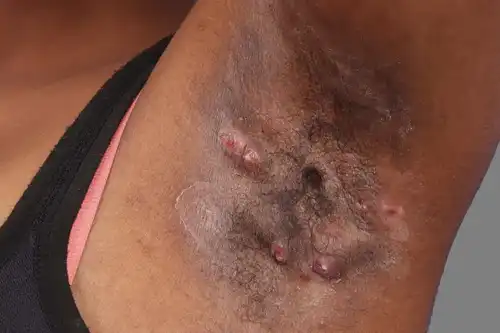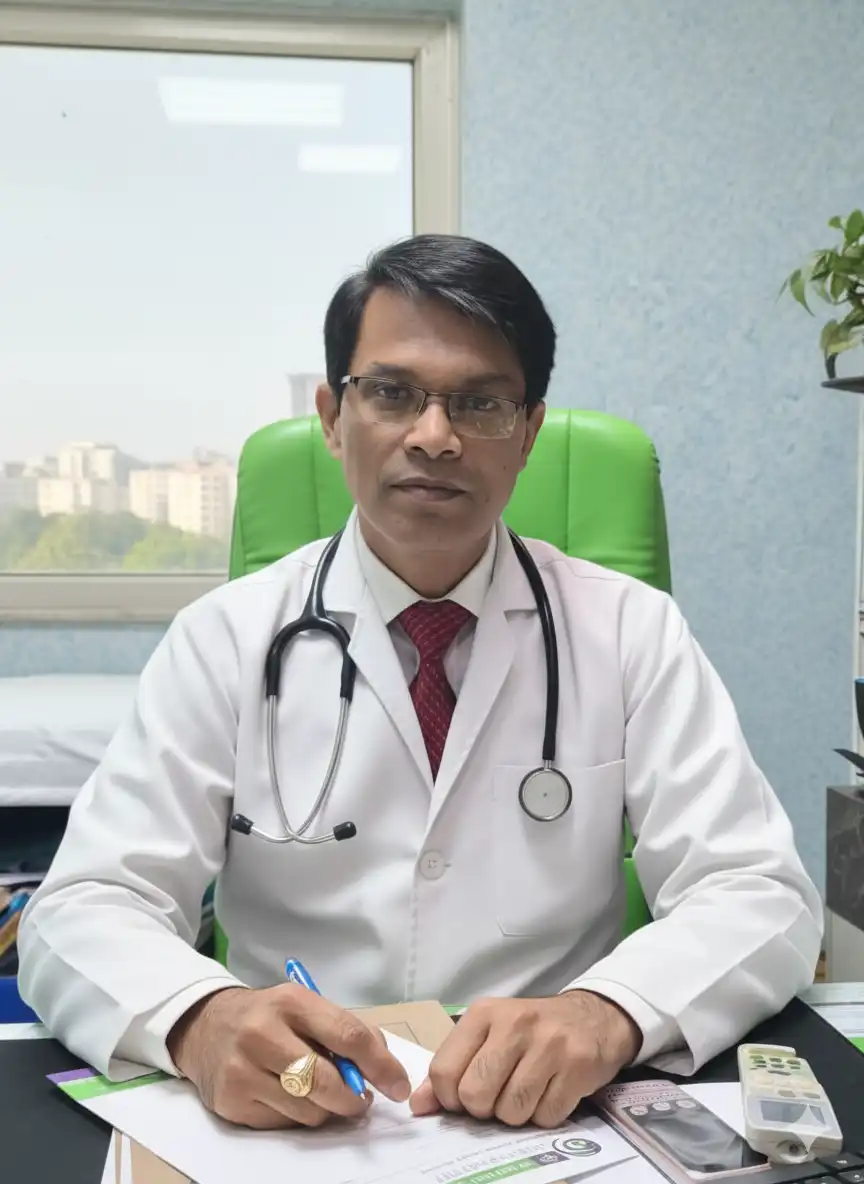
What is Hidradenitis Suppurativa?
Hidradenitis Suppurativa (HS) is a chronic inflammatory skin disease that causes painful lumps, abscesses, and tunnels (sinus tracts) under the skin. It most often affects areas where skin rubs together, such as the armpits, groin, buttocks, and under the breasts. HS is not an infection, not contagious, and not related to poor hygiene. It happens when hair follicles become blocked and inflamed. Over time, HS can lead to recurrent boils, pus drainage, and scarring. Early treatment helps manage symptoms, reduce flare-ups, and prevent complications. With proper care, people living with HS can improve comfort and quality of life.

What are the symptoms of hidradenitis suppurativa?
HS symptoms usually begin with small, tender lumps under the skin. These lumps may become painful, enlarge, and turn into abscesses that leak pus with a foul odor. Over time, tunnels (sinus tracts) may form under the skin, connecting abscesses. Scarring and thickened skin can develop in chronic cases. HS commonly affects the armpits, groin, inner thighs, buttocks, and under breasts. Symptoms may flare and subside, but the condition tends to be long-lasting. Pain, swelling, and discharge often interfere with daily life. Recognizing these early symptoms helps in seeking timely treatment and reducing complications from HS.
What causes hidradenitis suppurativa?
Blockage and inflammation of hair follicles and sweat glands
- An overactive immune system response is causing chronic inflammation
- Genetic factors – often run in families
- Hormonal influence – usually starts after puberty, may worsen with periods
- Lifestyle triggers – smoking, obesity, stress, sweating, skin friction
- Not contagious and not caused by poor hygiene
- Secondary bacterial infection may worsen symptoms, but it is not the root cause
Where does hidradenitis suppurativa occur on the body?
Hidradenitis suppurativa usually affects body areas with sweat glands and where skin rubs together. The most common sites include the armpits, groin, buttocks, inner thighs, and under the breasts. Less commonly, it may appear around the anus, waistline, or behind the ears. These areas are prone to friction, sweating, and hair follicle blockages, which trigger HS lumps and abscesses. The condition rarely occurs on the face, hands, or feet. Because HS tends to recur in the same regions, it can cause long-term scarring and discomfort. Identifying these affected sites helps doctors stage the disease and suggest proper treatment.
Where does hidradenitis suppurativa occur on the body?
Hidradenitis suppurativa usually affects body areas with sweat glands and where skin rubs together. The most common sites include the armpits, groin, buttocks, inner thighs, and under the breasts. Less commonly, it may appear around the anus, waistline, or behind the ears. These areas are prone to friction, sweating, and hair follicle blockages, which trigger HS lumps and abscesses. The condition rarely occurs on the face, hands, or feet. Because HS tends to recur in the same regions, it can cause long-term scarring and discomfort. Identifying these affected sites helps doctors stage the disease and suggest proper treatment.
How is hidradenitis suppurativa diagnosed?
HS is diagnosed mainly through a doctor’s physical examination and medical history. There is no specific blood test or scan for HS. Dermatologists recognize HS by its typical signs: recurrent painful lumps, abscesses, tunnels, and scars in characteristic locations like armpits, groin, and under the breasts. Doctors also ask about the frequency and duration of these boils. Sometimes, pus swabs are tested to rule out bacterial infections. In advanced stages, imaging may be used to detect sinus tracts under the skin. Early diagnosis is important to begin treatment, control symptoms, and prevent further complications or scarring from HS.
Is HS related to hormones?
Yes, hormones play an important role in hidradenitis suppurativa. HS often begins after puberty, worsens during menstruation, and sometimes improves after menopause. This pattern suggests hormonal influence, especially involving androgens (male hormones present in both men and women). Women with polycystic ovary syndrome (PCOS) are at higher risk of HS due to hormonal imbalance. Some treatments, such as birth control pills or anti-androgen medicines like spironolactone, may improve HS symptoms. While hormones are not the only cause, they can trigger or worsen flare-ups. Identifying hormonal connections helps doctors choose more effective treatment options for women with HS.
Does HS affect quality of life / mental health?
Yes, hidradenitis suppurativa significantly affects quality of life and mental health. Constant pain, pus drainage, odor, and scarring can cause embarrassment, leading to social withdrawal. Many patients experience low self-esteem, anxiety, and depression due to the chronic, visible, and unpredictable nature of the disease. Physical discomfort may interfere with work, relationships, and daily activities. The emotional burden is often as severe as the physical symptoms. Seeking medical treatment, counseling, and support groups helps patients cope better. Family understanding and social support are equally important. Managing HS improves both physical health and emotional well-being, restoring confidence and life quality.
Who is at risk for Hidradenitis Suppurativa (HS)?
Anyone can develop hidradenitis suppurativa, but some people are at higher risk. Women are affected more often than men, especially after puberty. Having a family history of HS increases the chances, showing a genetic link. Lifestyle factors such as smoking, obesity, stress, and sweating raise the risk and severity of flare-ups. People with hormonal imbalances, like polycystic ovary syndrome (PCOS), are also more prone. HS is more common between the ages of 18–40, though it can occur earlier or later. Understanding these risk factors helps in early diagnosis, prevention of complications, and timely treatment for better outcomes.
Treatment of Hidradenitis Suppurativa (HS) with Homoeopathy
Hidradenitis Suppurativa is a chronic and recurring skin disease that needs deep-acting treatment. Homoeopathy goes beyond temporary relief and focuses on the root causes of overactive immunity, hormonal imbalance, stress, and genetic predisposition. Remedies are selected on an individualized basis, considering the location of boils, tendency to pus formation, pain type, associated complaints, and even the mental and emotional state of the patient.
Homoeopathy helps in:
- Reducing the frequency and intensity of painful lumps
- Controlling pus discharge and foul odor
- Preventing tunneling and scarring of skin
- Improving immunity and hormonal balance
- Providing long-term relief without side effects
Unlike conventional medicines that suppress inflammation or require surgery in severe cases, homeopathy heals from within. With regular treatment and lifestyle guidance, many patients experience significant improvement, better confidence, and enhanced quality of life.
Why choose Dr. Sanjay’s Homoeopathy for Hidradenitis Suppurativa treatment in Lucknow, India?
Dr. Sanjay’s Homoeopathy is a trusted clinic for safe and effective Hidradenitis Suppurativa treatment in Lucknow, India. With years of expertise, Dr. Sanjay provides specialized Hidradenitis Suppurativa homeopathic treatment in Lucknow, India, that helps reduce painful lumps, abscesses, skin inflammation, and recurrent flare-ups naturally without side effects. As a leading homeopathic doctor in Lucknow, he follows international treatment standards and offers personalized care to address the root cause of this chronic skin condition. Patients choose Dr. Sanjay’s Homoeopathy for its holistic healing, proven results, and compassionate approach in managing long-term conditions like Hidradenitis Suppurativa.
